|
Special Features





Image Libraries


|
|
Blog
Best way to protect a bikeway? How about a bikeshare stationHow’s this for a natural idea: Locate bikeshare stations between a street’s protected bikeway and car lanes.
That’s exactly the arrangement in Crystal City, where the Capital Bikeshare station at 23rd and Eads helps to form part of the bikeway’s protective barrier.

23rd and Eads. Photo by Euan Fisk on Flickr.
DC has at least one example, on 6th Street NE next to Union Market. You can also find this arrangement in New York, Paris, and a ton of other cities.
It’s just a nifty, straightforward idea that’s too sensible not to use.
 Cross-posted at Greater Greater Washington. Cross-posted at Greater Greater Washington.
January 28th, 2015 | Permalink
Tags: bike, transportation, urbandesign

“Unstealable” bike transforms to become its own lockWhat if instead of carrying around a hand-held bike lock, your bike was its own lock? That’s the premise behind the Yerka Project, an attempt to design an “unstealable” bicycle.

Image from the Yerka Project.
The ingenious design works like this: The bike frame’s down tube splits into two pieces, each of which then twists so it’s perpendicular to the rest of the frame. Once the two pieces are turned 90 degrees, the bike seat pulls out of its tube, and slides into the down tube pieces, like a giant lock.
Thus, the frame of the bike becomes its own lock. The only way for a thief to break the lock is to break the entire bike.
There is a weakness, though: Individual components of the bike are still vulnerable. It’s only the frame itself that’s unstealable.
So far the designers have only produced a prototype, but the concept is straightforward enough that it could easily find its way to an assembly line. There are fewer moving parts than on a folding bike.
Still unsure how it works? Watch this example video:
Video from the Yerka Project.
 Cross-posted at Greater Greater Washington. Cross-posted at Greater Greater Washington.
January 15th, 2015 | Permalink
Tags: bike, transportation

“Park-Its” now protect the Pennsylvania Avenue bikewayAs of last week, rubber parking stops called “Park-Its” now protect a half block segment of the Pennsylvania Avenue protected bikeway, between 9th and 10th Streets NW.

The Park-Its are intended to protect cyclists from drivers making illegal U-turns across Pennsylvania Avenue’s median bike lanes.
DDOT crews installed the first Park-Its yesterday around 11:00 am. Workers will add more in the coming days, until Park-Its line the bikeway for the two block stretch from 9th to 11th.
Full installation of Park-Its all along Pennsylvania Avenue could eventually happen, but for now DDOT hopes to determine if this initial installation works. According to DDOT’s Darren Buck, the Park-Its on 1st Street NE sometimes pull up out of the pavement.
Park-Its succeed the zebras that DDOT installed in 2013, but which proved only partially effective. For now, the zebras between 12th and 13th Streets will remain in place.
 Cross-posted at Greater Greater Washington. Cross-posted at Greater Greater Washington.
December 22nd, 2014 | Permalink
Tags: bike, transportation

The Lincoln Memorial just became Capital Bikeshare’s busiest stationFor most its history, Capital Bikeshare’s busiest individual station has been at Dupont Circle. Not anymore. As of this summer, the Lincoln Memorial station is the new king.
This animation shows trips coming and going to the Lincoln station.

Video from Mobility Lab.
Capital Bikeshare’s most recent usage data is from its third quarter report, and covers the period from July 2014 through September.
During that period, the station at Massachusetts Avenue and Dupont Circle NW (historically the busiest) served 42,237 total trips. That’s an average of 459 per day.
But the Lincoln Memorial station served 44,177 total trips over the same period, averaging 480 per day.
Follow the tourists
Dupont Circle is usually the busiest station because it combines a nearly perfect storm of bikeshare ridership ingredients: Lots of nearby bike lanes, a Metro station feeding transfers, high job and population density, and a busy nightlife. It’s hopping at nearly all hours.
The Lincoln Memorial has virtually none of those things, but does have its own advantages. It’s one of the most popular parts of the National Mall, and is a far walk from convenient transit. For tourists who don’t want to drive and aren’t part of a group with a tour bus, bikeshare is an obvious way to access the Lincoln.
The animation shows how tourists drive most of the station’s usage. Blue lines show trips from regular members, while red lines are trips from short term users more likely to be tourists. Aside from a spike of blue around rush hour, the animation is a flood of red lines.
It probably won’t last
Will the new champion hold its spot, or will the Lincoln’s dynasty prove fleeting?
Tourists flock to Washington in the summer, but there are far fewer of them in the winter. When data for autumn comes out, it’s extremely unlikely the Lincoln will still be the busiest station. Odds are that honor will return to Dupont.
And next summer, bikeshare will face added competition from the new DC Circulator route scheduled to run along the National Mall beginning in 2015.
So this may well be the Lincoln’s only moment in the sun. It will be interesting to follow.
 Cross-posted at Greater Greater Washington. Cross-posted at Greater Greater Washington.
December 12th, 2014 | Permalink
Tags: bike, transportation

Capital Bikeshare needs smaller stations, but more of themThe most successful bikeshare systems in the world have dense networks with stations every few blocks, according to bikeshare guru Jon Orcutt. That suggests that as Capital Bikeshare expands, the agency should focus on adding small infill stations rather than adding more docks to make existing stations bigger.
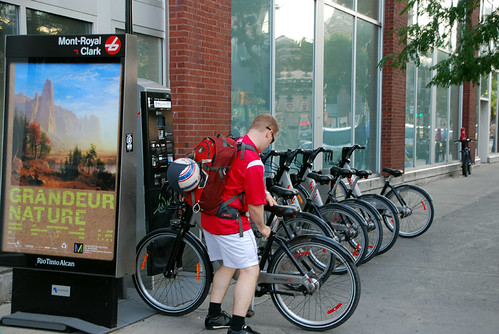
Bikeshare station in Montreal with only seven docks.
More stations are better
In a recent Streetsblog interview, Orcutt points out there’s a clear (and probably causal) correlation between bikeshare station density and bike usage. He cites the Institute for Transportation & Development Policy’s (ITDP) bikeshare planning guide, which bluntly states “increasing station density will yield increased market penetration.”
Simply put, systems with denser networks get more riders per bike per day.
That makes sense. Most bikeshare trips cover short distances, so the closer stations are to cyclists’ final destinations, the better. Conversely, it’s a major disincentive if riders have to walk more than a block or two to get to a station, and dockblocking is much more painful when the next closest station is many blocks away instead of right around the corner.
Since there are destinations on every block, the ideal bikeshare network would have stations on every block. That’s probably not practical even in the densest part of the city, but the best bikesharing networks seem to be those that come the closest. ITDP’s guide says to shoot for 10-16 stations per square kilometer.
And though Capital Bikeshare is one of America’s leading bikeshare systems, CaBi and nearly all its American peers lag world leaders in station density. That strongly suggests American bikeshare networks aren’t attracting as many riders as they could.

Image from the Institute for Transportation and Development Policy.
Politics matter, especially in the Washington region
With distinct clusters of stations in DC, Maryland, and Virginia, Capital Bikeshare is one of the most spread out systems in the world. But while that undeniably reduces the number of riders per bike, it clearly benefits CaBi politically, and therefore financially.
We’re lucky in this region to have a strong regional consensus on the benefits of bikesharing. It’s not just something that DC and Arlington do, which the suburbs grudgingly ignore. Alexandria and Montgomery take part. Fairfax and Prince George’s soon will. It’s a regional network that benefits everyone, and everyone has a stake in its success.
So it’s OK to spread stations out into distinct clusters in multiple jurisdictions, or even multiple wards of the same jurisdiction. But within each cluster, a large number of small stations is better than a handful of large ones.
There’s a catch
If smaller stations are better, why does Capital Bikeshare expand existing ones so often, rather than pour those resources into new station locations?
Simple: Because that would cost more.
Bikeshare stations are prefabricated. They come in basically three components: The kiosk section with the map and credit card terminal, snap-on docks, and the bikes themselves.
Each individual bikeshare station needs all three components, including the kiosk section. But expanding an existing station only takes more docks and more bikes, no kiosk. Thus, by expanding existing stations, CaBi reduces the need to buy expensive kiosk components. They can put out slightly more bikes and more docks with fewer, bigger stations.
Peak capacity versus peak access
Maximizing the number of bikes and docks is important too. The key question is whether it’s more important for a bikeshare agency to maximize peak capacity or peak access.
Putting out the most possible docks and bikes at a smaller number of stations makes the system more useful for rush hour commuters, but less useful for other trips. On the flip side, a system with slightly fewer docks but more stations would be less convenient for commuters, but would put more of the city within reach of a station.
Different bikeshare systems might rightly prioritize different expansion models at different times. But Capital Bikeshare is one of the more commute-oriented large systems in the world. It may be time to think about maximizing infill.
 Cross-posted at Greater Greater Washington. Cross-posted at Greater Greater Washington.
December 4th, 2014 | Permalink
Tags: bike, proposal, transportation

DC’s most bike-friendly corner: 15th and LLook at this beautiful photo. Two cycletracks meet at a street corner, bike boxes and green paint flow in every direction, and a bikeshare station sits in the background. It’s almost Dutch. Almost.
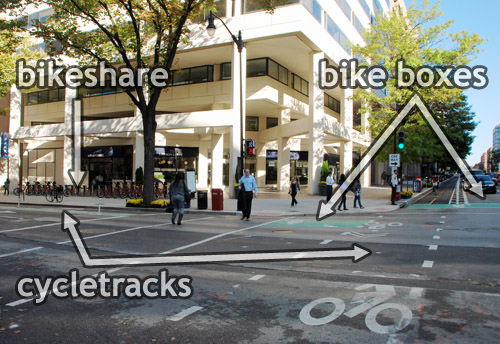
15th and L, NW.
This is the corner of 15th and L Streets, downtown. It’s the only intersection in the DC region (so far) where protected bike lanes extend out in all four directions. It’s also home to the only two-stage bike box in the region. And as of Tuesday, it’s got a sparkling new bikeshare station.
Whether or not it’s really DC’s most bike-friendly corner is debatable. Certainly the heavy car traffic at 15th and L can make biking there uncomfortable, even with cycletracks. And while most bike movements through this intersection are easy, there’s still no good way to turn right off the L Street cycletrack onto southbound 15th Street.
But no other corner in the city packs so much bike infrastructure into one spot. According to that metric at least, this corner is tops.
And it’s right outside the Washington Post’s headquarters.
Cross-posted at Greater Greater Washington.
October 9th, 2014 | Permalink
Tags: bike, transportation

The biggest bikeshare station in each US city
|
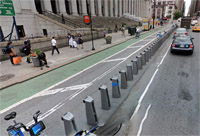
New York’s 67-dock station.
Photo from Google. |
Throughout 2014, DC and New York have jockeyed back and forth over which city’s bikeshare system has the most stations in the United States. But who has the biggest stations?
DC currently leads in the number of stations race, 335 to 324. But the number of stations only tells part of the story. New York’s stations are vastly bigger than DC’s, and by far the largest in the US.
New York’s biggest station, which is outside of Penn Station, has a whopping 67 docks. It’s almost 50% larger than the next city’s largest station.
Here’s the number of docks at the biggest station in America’s main big-city bikeshare systems:
 Cross-posted at Greater Greater Washington. Cross-posted at Greater Greater Washington.
August 29th, 2014 | Permalink
Tags: bike, transportation

Why build protected bike lanes, in one happy quoteA father and son comfortably bike down a slow Arlington street. They approach the new Hayes Street cycletrack. The father asks “Want to take the special bike lane?” The son responds with an excited “Yeah!”
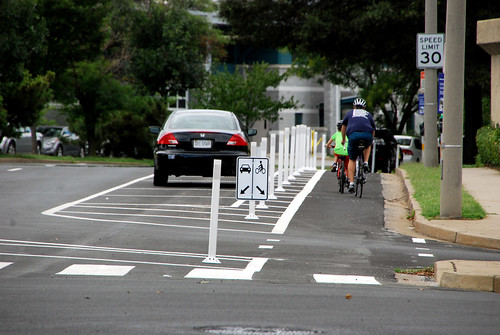
The father and son.
I overheard that interaction this past weekend, and had to stop and smile.
That one brief conversation sums up why protected bike lanes are so great: They make city streets safe, comfortable, and fun for even children to bicycle on. Not to mention older people, less-able people, and novice cyclists.
If Americans ever hope to make cycling for transportation a mainstream activity, cycling must feel comfortable for everyone. Getting bikes out of the path of speeding cars is a big part of that.
 Cross-posted at Greater Greater Washington. Cross-posted at Greater Greater Washington.
August 27th, 2014 | Permalink
Tags: bike, transportation

Protected bike lanes could fit in DC’s traffic circles; here’s howLondon is adding protected bike lanes to one of its traffic circles. Could the same design work in DC? Would we want it to?
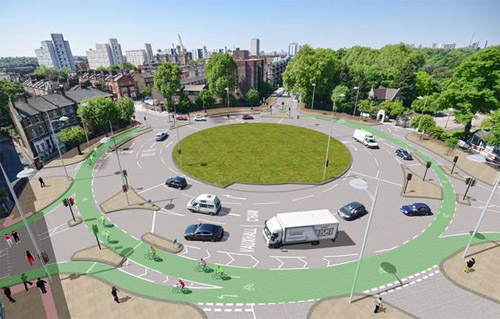
London traffic circle, with protected bike lanes in green. Image by London.
London city workers recently began rebuilding the Queen’s Circus traffic circle to include protected bike lanes. Since central DC has so many traffic circles, it’s worth considering whether the Queen’s Circus design could work here too.
DC’s big traffic circles are notoriously difficult places to bike. They have multiple lanes of intimidating and zig-zagging car traffic, and sidewalks too packed with pedestrians to be good bike paths. Most of the circles lack bike lanes, and those that have them (Columbus Circle and Thomas Circle) are still far from comfortable places to bike.
But the traffic circles are key destinations. People want to use them. Making the circles more bike friendly would be great for DC.
Would we want to do this?
This is sort of a good design. It’s better than nothing. But with so many crossings, it’s still pretty confusing what’s the bike lane and what’s for cars. It seems likely there will still be a lot of intimidating cross traffic.
In fact, the actual design doesn’t even have the green paint; I added that to make the rendering clearer.
The other big problem with the London example is that pedestrians are mostly absent. Unlike DC’s circles that typically have popular parks in the middle, this London circle is just a road. The central grassy section isn’t a useful park, and there are no pedestrian crossings into it. That obviously changes how the entire thing functions.
Look to the Dutch
Perhaps a better example might come from this traffic circle in Rotterdam, where in typically Dutch fashion the bike lanes are much more well protected.
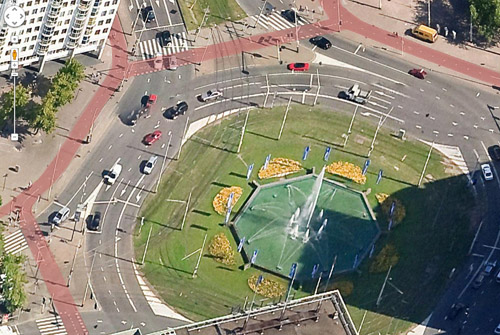
Rotterdam traffic circle, with protected bike lanes in red. Image by Google.
Rather than fight with cars, the Dutch put the bike lanes up on the sidewalk. That’s more ideal from a cyclist perspective, but it’s also much harder to accomplish.
The sidewalks around DC’s downtown circles are too narrow in many places to accommodate bike lanes. DDOT could theoretically rebuild the circles to have wider sidewalks and narrower roadways, but that would be controversial to say the least, not to mention a lot more expensive than striping a bike lane on the street.
The Dutch example is better, but the British example is more achievable.
 Cross-posted at Greater Greater Washington. Cross-posted at Greater Greater Washington.
August 21st, 2014 | Permalink
Tags: bike, transportation

A cycletrack appears in Pentagon CityArlington’s first significant protected bike lane quietly popped up last week in Pentagon City. It runs on South Hayes Street from 15th Street to Fern Street, next to Virginia Highlands Park.

South Hayes Street cycletrack. Photo by Darren Buck.
There are actually two cycletracks. There’s a grassy median in the middle of Hayes Street, so in order to serve bicyclists going both directions, each side of the street has its own one-way cycletrack next to the curb.
The cycletrack connects to the new green-painted bike lanes on Hayes Street further north, forming a spine for cycling through Pentagon City.
Technically speaking this is Arlington’s second cycletrack. The first one, in Rosslyn, is so short that it hardly counts. Hayes Street is the first significant one.
It’s great to see such high quality bike infrastructure appearing in more jurisdictions. Who will be next? Maybe Montgomery?
 Cross-posted at Greater Greater Washington. Cross-posted at Greater Greater Washington.
August 19th, 2014 | Permalink
Tags: bike, transportation

|
Media





Site
About BeyondDC
Archive 2003-06
Contact
Category Tags:
Partners
|

 Cross-posted at Greater Greater Washington.
Cross-posted at Greater Greater Washington.























